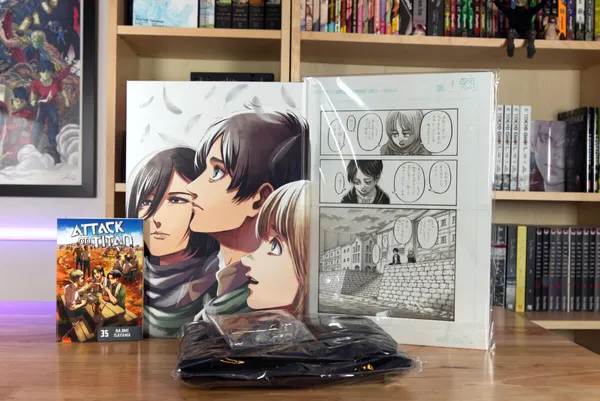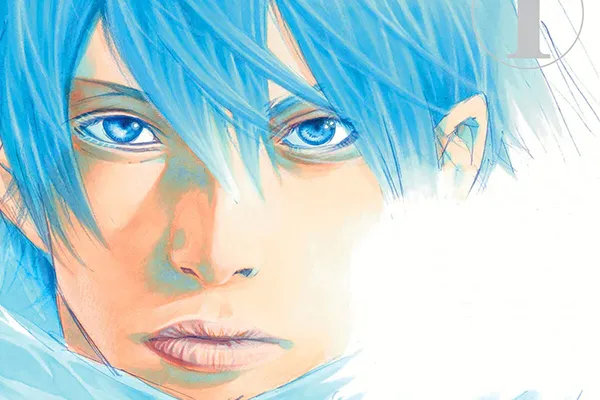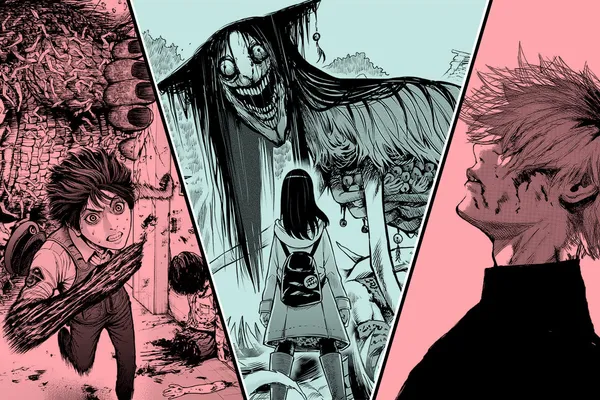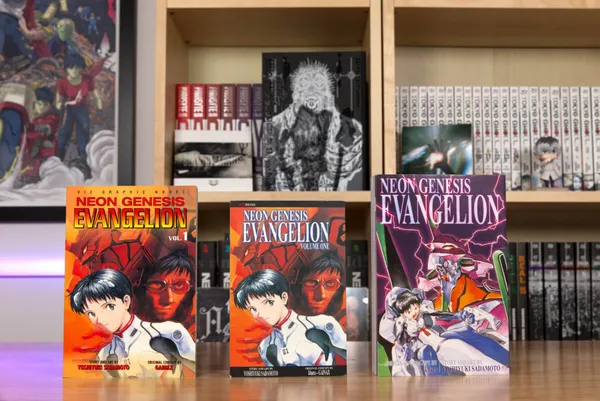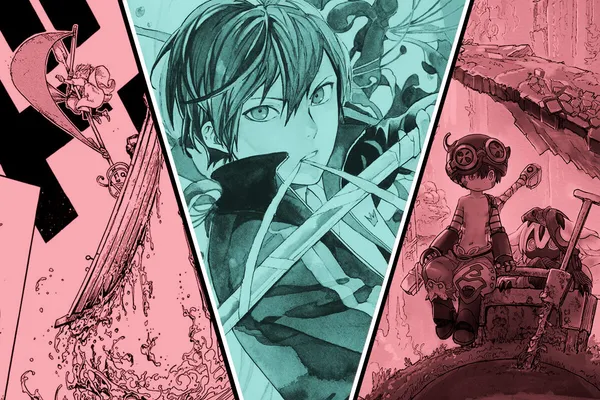Initial D debuted in the 90s, and to this day, it still reigns supreme as one of my top series to release, whether it be the anime, which is one of the best anime of the 90s, or the manga by Shuichi Shigeno, one of the best sports manga of all time. It’s one of those stories that you can just feel the love that the creator has put into it. There’s a true passion that comes through in Shuichi Shigeno’s work and this is part of what makes it so special.
Initial D follows Takumi Fujiwara, an 18-year-old who helps his father at his tofu shop by making deliveries. Every morning he heads out to Mt. Akina in his Dad’s AE86 to do so. Because of this daily routine, he has gained skills in mountain racing and drifting which were further honed day after day while driving to make a delivery at its summit.
Takumi’s daily life begins to change, though, when the Akagi RedSuns come into town to challenge the local team, the Akina SpeedStars. Takumi is a thrilling driver because he thinks out of the box and quickly adapts to every situation or challenge. The races are also entertaining and exhilarating, not just because of Takumi but because of the opponents he comes across as well.
Each with a unique driving style, every race feels fresh and the bar is constantly being raised. The races unfold in a way that makes them unexpected and exciting and the cars, whether in motion or not, are beautifully drawn. It’s one of my favorite manga to ever release and it’s an absolute classic through and through, so needless to say, I had long been dreaming of a new release of this series, so when Kodansha announced 2-in-1 omnibuses of the series I couldn’t have been more excited and the wait for Volume 1 is finally over.

Ways to Collect
You can collect Initial D with English translation via the Initial D omnibuses released by Kodansha or the singles that Tokyopop has released.
Initial D is complete with 48 volumes, so it is expected that 24 omnibuses will be released. This is the first time the series will be released in the United States since its initial release by Tokyopop in 2002. Tokyopop only released 33 of the 48 volumes, so the series is incomplete in this format.
Ease of Collecting
When it comes to ease of collecting, the Initial D omnibuses make getting into Initial D a lot more accessible for those looking to get into the series for the first time. As long as everything goes according to plan, this will be the first way you can collect the series fully with English translation, given that the Tokyopop singles stopped releasing at volume 33. Since the Tokyopop singles are out of print, are rare, and have a collectible nature given that select volumes came with collectible cards inside, they are harder to track down at a good price.
That said, you can find full sets from time to time, there are some listed on sites like eBay right now, but they are costly. You can find the Toykopop singles at used bookstores for lower prices, but given how hard it is to find the singles, buying them all in one go may be the most effective way to collect the series if you are looking to collect the singles. I have been searching for these singles for years, and have only come across them at my local used bookstores a handful of times, and it was usually volumes 1, 2, or 3, so this is something to keep in mind.
Price
As far as price goes, the 2-in-1s retail at USD 22.99. If Kodansha releases 24 omnibuses, as I suspect, the whole series will cost you around $552.
The out-of-print Toykopop singles, on the other hand, are only available for purchase on aftermarket sites. Since their prices vary and it’s hard to find a complete set for sale, it’s more difficult to pin down a price for them all. That said, I’ve seen full sets listed for $1000 or more, so you can expect to pay a lot more for the Tokyopop singles than you would the omnibuses.
Release Schedule
I also want to mention the release schedule since the omnibuses are a new release. Based on current listings on Barnes and Noble, it looks like they will be releasing a new omnibus every 2.5-3 months with the 2nd expected to be released on June 4, the third on September 3, and the fourth on December 3.

Variant Covers
There are a few variations you can shop for Omnibus 1 since select retailers are releasing exclusives. Kinokuniya released an exclusive cover that features the original artwork from the Japanese release along with exclusive shikishi art. In contrast, Crunchyroll released an exclusive cover that features the same cover seen in Volume 1 of the new editions of Initial D released that began in 2020 in Japan in celebration of the series’ 25th Anniversary. I like the addition of the glossy sound effects that were included with the Crunchyroll edition.
Kinokuniya has my favorite exclusive cover because it features the original cover art. Still, it’s awesome that they released three variations to choose from that all highlight various covers of Initial D from the original to the new Japanese editions and now the English omnibus release.

Size and Design
One of the most recognizable differences between the Tokyopop singles and the Kodansha 2-in-1s is their size and design. The Tokyopop singles are the same size as a standard manga release, like many Shonen Jump series, while the 2-in-1s are a larger, oversized format with dimensions of around 5.75 x 8.18 x 1.45in.
The first volume features full-color artwork of the AE86 in a way that makes it look like it’s popping out of the panel along with gold and red accent colors. Omnibus 1 has the Initial D logo in white above the AE86 with the volume number at the top. I like what they did with the design overall and think they will all look great together as more are released.
In future designs of the omnibuses, it looks like they are changing the base colors of the volumes and showcasing different cars from the series. We, of course, have Takumi’s AE86 on Omnibus 1. At the time of this post, only one other cover has been officially revealed, Omnibus 2, which features Keisuke Takahashi’s Yellow Mazda RX-7.
I will say that I am a fan of the original cover art that’s seen in the Japanese volumes. I prefer the design of the Omnibuses in comparison to the Tokyopop singles, though, which feature black and white artwork that was partially colorized on the front along with the Initial D logo at the top. The edges of the volumes and the spines are metallic silver. This is carried through all 33 singles along with the Initial D logo.

Print and Page Quality, Readability
When comparing page and print quality, the Kodansha omnibuses feature better contrast and the panels are more crisp overall. The paper in the omnibuses is better quality than the singles, printed on paper with an off-white color and eggshell-like texture.
A positive is that the panels stand out more thanks to the larger format, especially those two-page spreads. The Toykopop release was also printed on off-white paper but when you find them they often appear more yellow, which makes sense given their age. Despite this, the print quality in the Kodansha omnibuses is all-around better with darker blacks and more visible midtones, and you can see the details better as well.
That said, the paper Kodansha chose is more so the type you see in standard releases, and while the best you can collect, it isn’t as high quality as the paper we’ve seen in other omnibus releases, such as Homunculus and Innocent to name a few. I wanted to mention this because I think there is room for improvement with Kodansha’s omnibuses regarding page quality.
If they had gone with something like white paper with a smooth finish versus the off-white, texturized paper, the print quality in these would have been better. The page and print quality aren’t bad by any means. Honestly, I’m excited to collect Initial D finally, but I wanted to note this as potential room for growth for Kodansha as they release more omnibuses.
Readability-wise, I have no issues to report with either release as both are similar with their glued spines. The singles are comfortable and easy to read, but so are the omnibuses. Since they went with omnibuses, I’m glad they did 2-in-1s instead of 3-in-1s, because they are easier to read and this helps with gutter loss. There are issues with gutter loss from time to time, particularly with 2-page spreads, but nothing that I would consider a deal-breaker. I noticed fewer gutter loss issues, though, in the omnibuses than in the singles thanks to their larger format.

Translation, Lettering, and Sound Effects
One of the most notable differences between the two editions is their translation and lettering. The updated translation and lettering featured in the new 2-in-1 omnibuses make them stand apart from the original Tokyopop singles. These translation improvements are consistent with other series I’ve picked up that were initially released by Tokyopop and later updated by other publishers. Generally, I’ve noticed that these newer editions consistently have better translations than their Tokyopop counterparts, which makes sense given the time many of their series were released. The omnibus editions have markedly better translations than the older Tokyopop versions.
The updated omnibuses have corrected grammatical and structural errors with dialogue that sounds more natural and flows smoothly. On top of that, these revisions offer a more accurate representation of the original content and it reads better overall as a result. Kodansha did a complete overhaul of the translation, so much so that it reads like an entirely different series to the Tokyopop singles but this is a good thing. The translation is way better in the omnibuses and the characters’ conversations feel more natural and accurate.
The lettering has seen a significant upgrade in the 2-in-1 omnibuses too. The lettering seems to fit the series more compared to the Tokyopop singles. The layout of the dialogue boxes makes them easier to read but also enhances their aesthetic appeal, and they highlight various words or phrases for emphasis and emotion.
Overall, the 2-in-1 omnibuses feel more complete as a result. I appreciate that they kept the original hand-drawn sound effects as well. Another new addition to these omnibuses is they’ve added translated sound effects directly on the page underneath the original hand-drawn sound effects. In the Tokyopop singles, the sound effects were left untranslated, so if you prefer to have translations, the Kodansha omnibuses are the only release with them.

New Material or Extras
I didn’t notice any new material in the Kodansha omnibuses vs the Tokyopop singles aside from some nice color pages in the beginning. The color pages they included at the start of the omnibuses are beautiful and printed on matte white paper similar to that used in the Parasyte Full Color Collections.
They also included a full-color page featuring Volume 1’s cover art, which is a nice addition, but it’s the two-page spread of Takumi and his AE86 I love the most. I’m happy they included these color pages because they are a nice addition.
Final Verdict
Now that we’ve gone over everything, what’s the best way to collect Initial D? Since the Tokyopop singles don’t fully collect the series and they have worse page and print quality as well as worse lettering and translation and are expensive to collect given that they are out of print, I would not recommend collecting them unless you are a major fan of the series and want to own them.
The Kodansha omnibuses are a more cost-effective way to collect the series and they have made massive improvements to the translation, they have better page and print quality than the singles, and the panels stand out more thanks to their larger format. They are hands down the best way to collect the series with English translation, and I couldn’t be happier that Kodansha is releasing one of the all-time greats, Initial D.


